This guide initially displays common arthropods (insects, arachnids, centipedes/millipedes and crustaceans) of all shapes. Use the selectors below to include rare species, select by shape, or search by name.
Arthropods include several different classes: hexapods, arachnids, myriapods and crustaceans. An arthropod is an invertebrate animal with bilateral symmetry, an external skeleton, a segmented body, and jointed appendages arranged in pairs. In order to grow, arthropods have to molt, shedding their whole exoskeleton all at once.
Insects, which comprise the vast majority of hexopods, all have three basic body parts. The head has compound eyes, mouthparts, and antennae that are used as sensory organs. The thorax or mid-section typically has two pairs of wings, if the insect can fly, and three pairs of legs for a total of six. The abdomen contains the insect’s digestive system, reproductive organs and sting organs, if present.
While spiders make up the largest group of arachnids, others in the class include scorpions, harvestmen, ticks, mites, pseudoscorpions and solifuges. Arachnids have eight legs plus two additional pairs of appendages: chelicerae used for feeding and defense and pedipalps which function as a sensory organ or in reproduction. Arachnids do not have antennae or wings and have two main body parts with the head and thorax fused into one. In addition, they have two different types of eyes for a total of eight.
Centipedes and millipedes make up most of the myriapod species. They are best known for their long, segmented bodies with multiple legs, though far fewer than their names imply. In addition, they have a single pair of antennae, simple eyes, and mouthparts on the underside of their bodies.
Most crustaceans are free-living aquatic animals but a few are terrestrial such as the woodlice. Their bodies are composed of segments that are grouped into three regions: head, thorax and abdomen. Each body segment may have one or more pairs of appendages which serve as antennae, mandibles, maxillae, legs and tail.
Over 80% of all living animal species are arthropods. They occupy all kinds of roles: predators, prey, parasites, hosts, herbivores and decomposers and live in all different types of habitats. Many are particularly adapted to life in a dry environments like that of Southwest. This guide focuses on many of the common arthropods in the greater Los Alamos area. However, please note that insects in the Lepidoptera order are discussed separately in the Butterfly and Moth Guide.
Insect, Spider and Kin References
A Checklist of Plant and Animal Species at Los Alamos National Laboratory and Surrounding Areas
A Guide to Arthropods Bandelier National Monument, National Park Service [PDF]
American Arachnological Society
Arnett, RH, Jr. 2000 American Insects: A Handbook of the Insects of America North of Mexico CRC Press
BugGuide.Net
Encyclopedia of Life
Field Guide to Insects and Diseases of Arizona and New Mexico Forests, US Forest Service [PDF]
Grasswitz, T.R. and Dressen, D.R. Pocket Guide to the Native Bees of New Mexico [PDF]
Grasswitz, T.R. and Dressen, D.R. Pocket Guide to the Beneficial Insects of New Mexico [PDF]
A Manual of Grasshoppers of New Mexico
iNaturalist
Insect Identification, New Mexico
Mackay, W. and Mackay, E., 2001 The Ants of New Mexico (Hymenoptera: Formicidae) [PDF]
Museum of Southwestern Biology
New Mexico Spiders
Odonata Central
One Hundred Common Insects of New Mexico, NM State University [PDF]
Sanborn, A.F. and Phillips, P.K., 2013 Biogeography of the Cicadas (Hemiptera: Cicadidae) of North America, North of Mexico [PDF]
Symbiota Collections of Arthropods Network
Sutherland, C.A. Rove Beetles [PDF]
Symbiota Collections of Arthropods Network
Ticks and Tick Borne Diseases
Wildlife Notes – Centipedes and Millipedes [PDF]
Subject Area Experts (all guides)
Steve Cary (butterflies)
Beth Cortright (insects)
Terry Foxx (invasive plants)
Leslie Hansen (mammals)
Richard Hansen (fish, mammals)
Dorothy Hoard (butterflies, trees)
Chick Keller (flowers, herbarium)
Shari Kelley (geology)
Kirt Kempter (geology)
Garth Tietjen (reptiles)
David Yeamans (birds)
Web Development and Content Management
Pat Bacha
Jennifer Macke
Graham Mark
Akkana Peck
Contact
Please contact us for local nature questions and sightings. We welcome comments, corrections, and additions to our guides.
For more information about local nature, please visit our Nature Blog or subscribe to PEEC This Week.
Make Selection
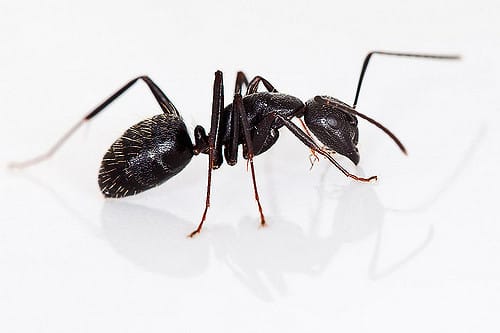 Photo: Dmitry Mozzherin |  Carpenter Ant(Camponotus spp., Formicidae family)Order: Hymenoptera (Ants, Bees and Wasps) Size: 0.3 - 1 in (8 - 25 mm) Distinguishing Features: large, broad head with thin waist; highly variable in overall size Status: native; common Habitat: nests in logs and stumps under trees but can invade homes. The genus Camponotus contains a very large number of species known collectively as Carpenter Ants. One of the most common US species associated with human habitation is the black carpenter ant (Camponotus pennsylvanicus). Though these ants chew out areas inside wood for their nests, they do not eat it. They usually feed on seeds but still can cause structural damage in a home. These ants bite but do not sting. Info Photos |
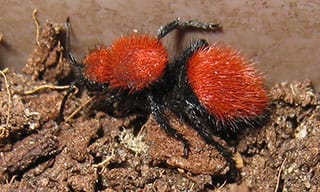 Photo: Jennifer Macke |  Velvet Ant, Cow Killer(Dasymutilla spp., Mutillidae family)Order: Hymenoptera (Ants, Bees and Wasps) Size: 0.8 - 0.9 in (19 - 22 mm) Distinguishing Features: ant-like with only a slight constriction between the the thorax and abdomen; usually red or orange, but may also be yellow or white; covered with obvious hair; males are winged; females wingless Status: native; uncommon Habitat: arid and semiarid open lands These hairy wasps move quickly along the ground and are often mistaken for ants. They can make a squeaking noise by rubbing their abdominal segments together. Males do not sting, but females can deliver a very painful sting, giving velvet ants the nickname of Cow Killer. Larvae are external parasites to various types of other Hymenoptera, such as ground-nesting bees. Info Photos |
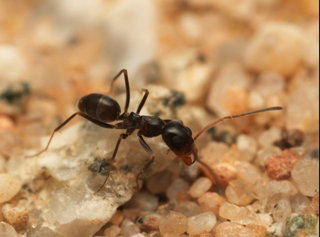 Photo: Jesse Rorabaugh 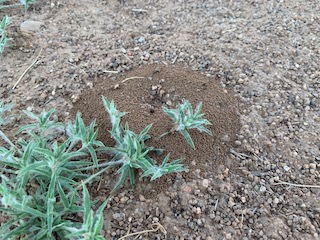 Photo: Mound created by crazy ants. The surrounding pebbles are part of a nearby harvester ant mound. by Jennifer Macke |  Crazy Ant, Crazy Pyramid Ant, Pyramid Ant(Dorymyrmex insanus)Order: Hymenoptera (Ants, Bees and Wasps) Size: up to 0.1 in (2 mm) Distinguishing Features: small; dark brown; large eyes; distinctive nest with a small mound of dirt Status: native; common Habitat: open sunny areas A small ant that is often overlooked, but very common. It is especially common in disturbed soil in hot arid places. It is recognized by its small mound nests, about 4 inches in diameter, and by its behavior. If you disturb the nest, the ants run around frantically, giving it the common name "crazy ant". Its mound nests often appear in the cracks in sidewalks and around the perimeter of harvester ant mounds (especially P. rugosus and P. occidentalis). The crazy ants and harvester ants appear to coexist well. Info Photos |
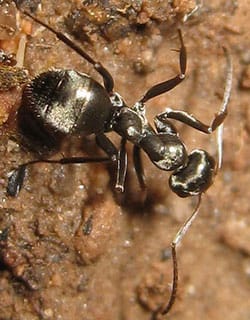 Photo: Jennifer Macke |  Black Lawn Ant(Formica podzolica, Formicinae family)Order: Hymenoptera (Ants, Bees and Wasps) Size: 0.2 - 0.3 in (4 - 8 mm) Distinguishing Features: abdomen is somewhat reflective, giving the illusion of a white band Status: native; common Habitat: yards and wooded areas Often live under rocks in landscaped areas though may be found in coniferous forests where their mounds are covered by herbaceous plants. They feed on dead invertebrates and nectar. They are active in daytime but considered rather shy. Info Photos |
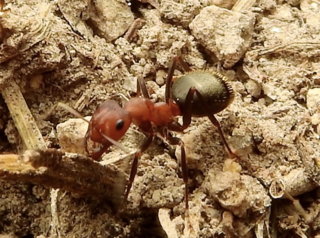 Photo: Tim Shortell |  Wood Ant, Field Ant(Formica spp., Formicidae family)Order: Hymenoptera (Ants, Bees and Wasps) Size: 0.1 - 0.5 in (3 - 13 mm) Distinguishing Features: medium-sized ant that is rusty red to dark brown or black, with a single segment between the thorax and the abdomen Status: native; common Habitat: wooded areas but can be found in and near structures like sidewalks and building foundations Wood ants belong to the Formica genus, and the species are not easy to tell apart. Typically they secrete formic acid, and some can squirt it several feet if alarmed. Nests are often constructed close to small trees and shrubs surrounded by dirt or bits of detritus. The number of ants in a nest can be quite large. Info Photos |
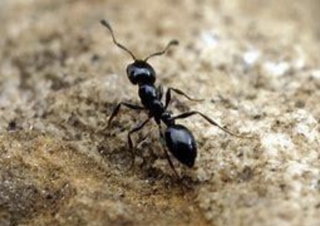 Photo: Isabella Brown |  Little Black Ant, Common Trailing Ant(Monomorium minimum, Formicidae family)Order: Hymenoptera (Ants, Bees and Wasps) Size: 0.1 in (2 mm) Distinguishing Features: tiny and have very little body hair. They are shiny black to dark brown with a single segment between the thorax and abdomen; end of the antennae is club-shaped Status: native; common Habitat: forest edges but often invades buildings Little Black Ants are the most common ants in homes and often are seen carrying food back to their nest. They are scavengers, eating a wide variety of potential foodstuffs. Nests are usually constructed below ground with a small crater at the opening or in rotting wood. Info Photos |
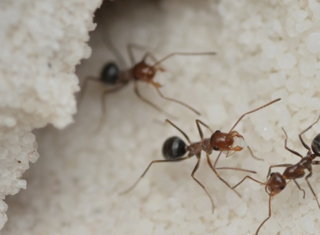 Photo: Robby Deans 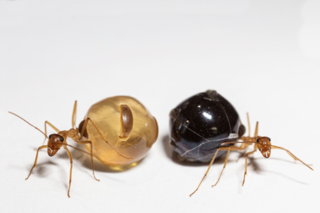 Photo: Repletes by pseudomyrmex 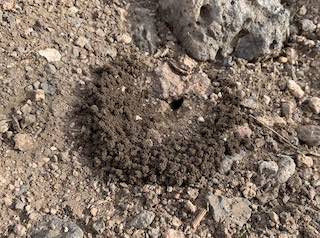 Photo: Founding chamber of a honeypot ant. by Jennifer Macke |  Honeypot Ant, Honey Ant(Myrmecocystus spp., Formicidae family)Order: Hymenoptera (Ants, Bees and Wasps) Size: 0.1 - 0.2 in (3 - 5 mm) Distinguishing Features: medium sized; elongated maxillary palpi; coloration is either reddish with black abdomen, or completely yellow-brown Status: native; locally common Habitat: nests in the soil in arid and semi-arid regions These ants prefer to locate their nests in open areas between plants. The nest entrance is a rounded crater made of small pebbles and soil surrounded by discarded debris. Honeypot ants have a group of specialized workers known as repletes, plerergates, or rotunds. These workers have an abdomen with stiff plates and soft connective tissue that can greatly expand when they gorge themselves on nectar. Repletes hang from the ceiling deep within the nest and serve as living storage containers. Ordinary workers extract food from the repletes through a process known as trophallaxis. This food/water storage system makes them well suited to desert environments. Honeypot ants have foraging territories, and colonies will engage in ritualized battles. If a colony is weak, a stronger colony will raid it, taking its brood and repletes. Info Photos |
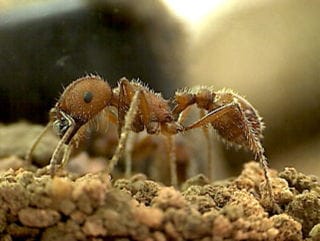 Photo: Beth Cortright 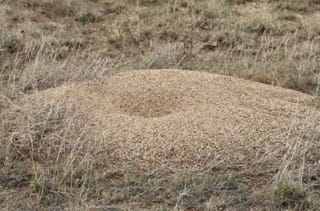 Photo: Melissa |  Harvester Ant(Pogonomyrmex spp., Formicidae family)Order: Hymenoptera (Ants, Bees and Wasps) Size: 0.1 - 0.3 in (2 - 8 mm) Distinguishing Features: largish ant; red or black; blocky head with a beard of coarse hairs and a threadlike waist; distinctive nests Status: native; common Habitat: open, arid areas Harvester ants collect edible seeds and pollen, but will also forage on dead insects and nectar. Colonies are topped with a distinctive conical mound of fine gravel and surrounded by areas devoid of plant life. A colony can contain up to 20,000 workers produced by a single queen. These ants have a painful sting, but are not very aggressive towards humans. Sometimes mistaken for Fire Ants, but not related; Fire Ants are not found in the region around Los Alamos. The most common Harvester Ants in Los Alamos and White Rock are P. occidentalis (Western Harvester Ant), while White Rock also has P. rugosus (Rough Harvester Ant), which is mostly black in color. Info Photos |
